Study of Concrete Moisture Transfer Characteristics in the Presence of the Concrete Micro–Meso Structure Effect
Abstract
1. Introduction
2. Multi-Scale Moisture Diffusion Coefficient Model of Concrete
2.1. Effective Moisture Diffusion Coefficient of Cement Paste
2.2. Effective Moisture Diffusion Coefficient of Mortar and Concrete
2.3. Model Validation
3. Meso-Scale Simulation of Moisture Transfer Characteristics
3.1. Calculation Parameters and Models
3.2. Mesoscopic Moisture Migration Characteristics in Wetting and Drying
3.2.1. RH Distribution and “Flow Around” Phenomenon in Wetting and Drying
- (1)
- Wetting process
- (2)
- Drying process
3.2.2. Difference in Moisture Diffusion Characteristics Between Wetting and Drying
4. Discussion
4.1. The Effect of Pore Size and Water-to-Cement Ratio on Moisture Transfer
4.2. The Effect of ITZ Thickness and Aggregate Volume Fraction on Moisture Transfer
5. Conclusions
- (1)
- The moisture diffusion coefficient model of concrete considering microstructure quantifies the role of Knudsen diffusion in moisture migration, which can effectively consider the effects of pore size distribution, aggregate content, and excessive interface on moisture migration;
- (2)
- The pore size distribution has a great influence on the humidity diffusion coefficient, and the humidity is more likely to migrate through the pores of 10~100 nm. Knudsen diffusion reduces the moisture diffusion coefficient of concrete to a certain extent, and its influence increases with the increase in the water–cement ratio and decreases with the increase in relative humidity, which also leads to the increase in the moisture diffusion coefficient with the increase in relative humidity to a certain extent;
- (3)
- The transient moisture migration of concrete has obvious non-uniformity. There is a “flow around” phenomenon at the edge of aggregate, and water is more likely to be transmitted through the excessive interface. With the increase in the aggregate volume fraction, the excessive interface with a higher moisture diffusion coefficient also increases, but the influence of the additional excessive interface on the overall moisture diffusion coefficient is less than that of the aggregate “dilution” effect;
- (4)
- The “S”-type growth relationship between the moisture diffusion coefficient and relative humidity of concrete includes the difference in the moisture diffusion coefficient between the wetting and drying process, which makes wetting faster than drying. At the same time, the jump growth of the moisture diffusion coefficient is also the main reason for the “inflection point” of the humidity distribution inside the concrete during the wetting and drying process.
Author Contributions
Funding
Institutional Review Board Statement
Informed Consent Statement
Data Availability Statement
Conflicts of Interest
References
- Gao, Y.; Zhang, J.; Luosun, Y. Shrinkage Stress in Concrete Under Dry-Wet Cycles: An Example with Concrete Column. Mech. Time-Depend. Mater. 2014, 18, 229–252. [Google Scholar] [CrossRef]
- Fathifazl, G.; Ghani Razaqpur, A.; Burkan Isgor, O.; Abbas, A.; Fournier, B.; Foo, S. Creep and Drying Shrinkage Characteristics of Concrete Produced with Coarse Recycled Concrete Aggregate. Cem. Concr. Compos. 2011, 33, 1026–1037. [Google Scholar] [CrossRef]
- Baluch, M.; Asad, M.; AI-Gadhib, A. Drying Shrinkage Stresses in Concrete Patch Repair Systems. Mag. Concr. Res. 1997, 49, 283–293. [Google Scholar] [CrossRef]
- Klysz, G.; Balayssac, J.P. Determination of Volumetric Water Content of Concrete Using Ground-Penetrating Radar. Cem. Concr. Res. 2007, 37, 1164–1171. [Google Scholar] [CrossRef]
- Li, C.; Li, K.; Chen, Z. Numerical Analysis of Moisture Influential Depth in Concrete and Its Application in Durability Design. Tsinghua Sci. Technol. 2008, 13, 7–12. [Google Scholar] [CrossRef]
- De Weerdt, K.; Orsáková, D.; Müller, A.C.A.; Larsen, C.K.; Pedersen, B.; Geiker, M.R. Towards the Understanding of Chloride Profiles in Marine Exposed Concrete, Impact of Leaching and Moisture Content. Constr. Build. Mater. 2016, 120, 418–431. [Google Scholar] [CrossRef]
- Yin, G.J.; Li, L.B.; Wen, X.D.; Miao, L.; Wang, S.S.; Zuo, X.B. Numerical Modelling on Moisture and Sulfate Ion Transport in Unsaturated Concrete Slab under Dry-Wet Cycles. J. Build. Eng. 2024, 89, 109296. [Google Scholar] [CrossRef]
- Saetta, A.V.; Schrefler, B.A.; Vitaliani, R.V. The Carbonation of Concrete and the Mechanism of Moisture, Heat and Carbon Dioxide Flow through Porous Materials. Cem. Concr. Res. 1993, 23, 761–772. [Google Scholar] [CrossRef]
- Nadeau, J.C. Water-Cement Ratio Gradients in Mortars and Corresponding Effective Elastic Properties. Cem. Concr. Res. 2002, 32, 481–490. [Google Scholar] [CrossRef]
- Wang, J.; Li, H.; Ma, C.; Cai, C.; Wang, J. Effect of Surface Curing Condition on the Humidity Field and Moisture Transfer in Concrete. Constr. Build. Mater. 2024, 411, 134701. [Google Scholar] [CrossRef]
- Zhang, J.; Wang, J.; Han, Y. Simulation of Moisture Field of Concrete with Pre-Soaked Lightweight Aggregate Addition. Constr. Build. Mater. 2015, 96, 599–614. [Google Scholar] [CrossRef]
- Bissonnette, B.; Pierre, P.; Pigeon, M. Influence of Key Parameters on Drying Shrinkage of Cementitious Materials. Cem. Concr. Res. 1999, 29, 1655–1662. [Google Scholar] [CrossRef]
- Zhang, Z.; Zhang, J. Experimental Study on the Relationship Between Shrinkage Strain of Concrete and Environmental Humidity. J. Build. Mater. 2006, 9, 720–723. (In Chinese) [Google Scholar]
- Zhang, J.; Dongwei, H.; Wei, S. Experimental Study on the Relationship Between Shrinkage and Interior Humidity of Concrete at Early Age. Mag. Concr. Res. 2010, 62, 191–199. [Google Scholar] [CrossRef]
- Patel, R.A.; Perko, J.; Jacques, D.; De Schutter, G.; Ye, G.; Van Bruegel, K. Effective Diffusivity of Cement Pastes from Virtual Microstructures: Role of Gel Porosity and Capillary Pore Percolation. Constr. Build. Mater. 2018, 165, 833–845. [Google Scholar] [CrossRef]
- Kang, S.T.; Kim, J.S.; Lee, Y.; Park, Y.D.; Kim, J.K. Moisture Diffusivity of Early Age Concrete Considering Temperature and Porosity. KSCE J. Civ. Eng. 2012, 16, 179–188. [Google Scholar] [CrossRef]
- Liu, C.; Liu, Z.; Zhang, Y. A Multi-Scale Framework for Modelling Effective Gas Diffusivity in Dry Cement Paste: Combined Effects of Surface, Knudsen and Molecular Diffusion. Cem. Concr. Res. 2020, 131, 106035. [Google Scholar] [CrossRef]
- Nambiar, E.K.K.; Ramamurthy, K. Sorption Characteristics of Foam Concrete. Cem. Concr. Res. 2007, 37, 1341–1347. [Google Scholar] [CrossRef]
- Ben Fraj, A.; Bonnet, S.; Khelidj, A. New Approach for Coupled Chloride/Moisture Transport in Non-Saturated Concrete with and without Slag. Constr. Build. Mater. 2012, 35, 761–771. [Google Scholar] [CrossRef]
- Yang, C.C.; Su, J.K. Approximate Migration Coefficient of Interfacial Transition Zone and the Effect of Aggregate Content on the Migration Coefficient of Mortar. Cem. Concr. Res. 2002, 32, 1559–1565. [Google Scholar] [CrossRef]
- Krus, M. Moisture Transport and Storage Coefficients of Porous Mineral Building Materials. Theoretical Principles and New Test Methods; Fraunhofer-IRB-Verlag: Stuttgart, Germany, 1996; pp. 1–172. [Google Scholar]
- Zhang, X.; Su, M.; Yu, W.; Lei, Z.; Ren, J.; Qu, J. Experimental and Numerical Research on Water Transport during Adsorption and Desorption in Cement-Based Materials. Comput. Model. Eng. Sci. 2023, 136, 1487–1507. [Google Scholar] [CrossRef]
- Wang, L.; Bao, J.; Ueda, T. Prediction of Mass Transport in Cracked-Unsaturated Concrete by Mesoscale Lattice Model. Ocean Eng. 2016, 127, 144–157. [Google Scholar] [CrossRef]
- Bažant, Z.P.; Najjar, L.J. Nonlinear Water Diffusion in Nonsaturated Concrete. Matériaux Constr. 1972, 5, 3–20. [Google Scholar] [CrossRef]
- Ding, X.; Zhang, J.; Wang, J. Integrative Modeling on Self-Desiccation and Moisture Diffusion in Concrete Based on Variation of Water Content. Cem. Concr. Compos. 2019, 97, 322–340. [Google Scholar] [CrossRef]
- Kärger, J.; Ruthven, D.M.; Theodorou, D.N. Diffusion in Nanoporous Materials; Wiley-VCH Verlag GmbH & Co. KGaA: Weinheim, Germany, 2012; ISBN 9783527310241. [Google Scholar]
- Blundell, S.J.; Blundell, K.M. Concepts in Thermal Physics; Oxford University Press: Oxford, UK, 2010; pp. 1–512. ISBN 9780199562091. [Google Scholar] [CrossRef]
- Uno, P.J. Plastic Shrinkage Cracking and Evaporation Formulas. ACI Mater. J. 1998, 95, 365–375. [Google Scholar]
- Bažant, Z.P. Constitutive Equation for Concrete Creep and Shrinkage Based on Thermodynamics of Multiphase Systems. Matériaux Constr. 1970, 3, 3–36. [Google Scholar] [CrossRef]
- Ghanbarian, B.; Hunt, A.G.; Ewing, R.P.; Sahimi, M. Tortuosity in Porous Media: A Critical Review. Soil Sci. Soc. Am. J. 2013, 77, 1461. [Google Scholar] [CrossRef]
- Torquato, S. Random Heterogeneous Materials: Microstructure and Macroscopic Properties. Appl. Mech. Rev. 2002, 55, B62. [Google Scholar]
- Duan, H.L.; Karihaloo, B.L.; Wang, J.; Yi, X. Effective Conductivities of Heterogeneous Media Containing Multiple Inclusions with Various Spatial Distributions. Phys. Rev. B 2006, 7360, 4203. [Google Scholar] [CrossRef]
- Vosteen, H.D.; Schellschmidt, R. Influence of Temperature on Thermal Conductivity, Thermal Capacity and Thermal Diffusivity for Different Types of Rock. Phys. Chem. Earth 2003, 28, 499–509. [Google Scholar] [CrossRef]
- Bourdette, B.; Ringot, E.; Ollivier, J.P. Modelling of the Transition Zone Porosity. Cem. Concr. Res. 1995, 25, 741–751. [Google Scholar] [CrossRef]
- CEB-FIP Model Code 2010 Final Draft; Comité Euro-International du Béton: Lausanne, Switzerland, 2011; 594p.
- Zhao, L.; Wang, P.; Wang, L.; Zhao, T.; Guang, W. Analysis of Parameters for Temperature and Humidity Response in Concrete: Moisture Diffusion Coefficient and Thermal Conductivity. Mater. Rep. 2021, 35, 6. (In Chinese) [Google Scholar]
- Huang, D.H.; Liu, G.T. Study on Mass Diffusivity of Concrete under Isothermal Condition. J. Basic Sci. Eng. 2002, 10, 386–394. [Google Scholar]
- Akita, H.; Fujiwara, T.; Ozaka, Y. A Practical Procedure for the Analysis of Moisture Transfer within Concrete Due to Drying. Mag. Concr. Res. 1997, 48, 129–137. [Google Scholar] [CrossRef]
- Ma, H.; Li, Z. Realistic Pore Structure of Portland Cement Paste: Experimental Study and Numerical Simulation. Comput. Concr. 2013, 11, 317–336. [Google Scholar] [CrossRef]
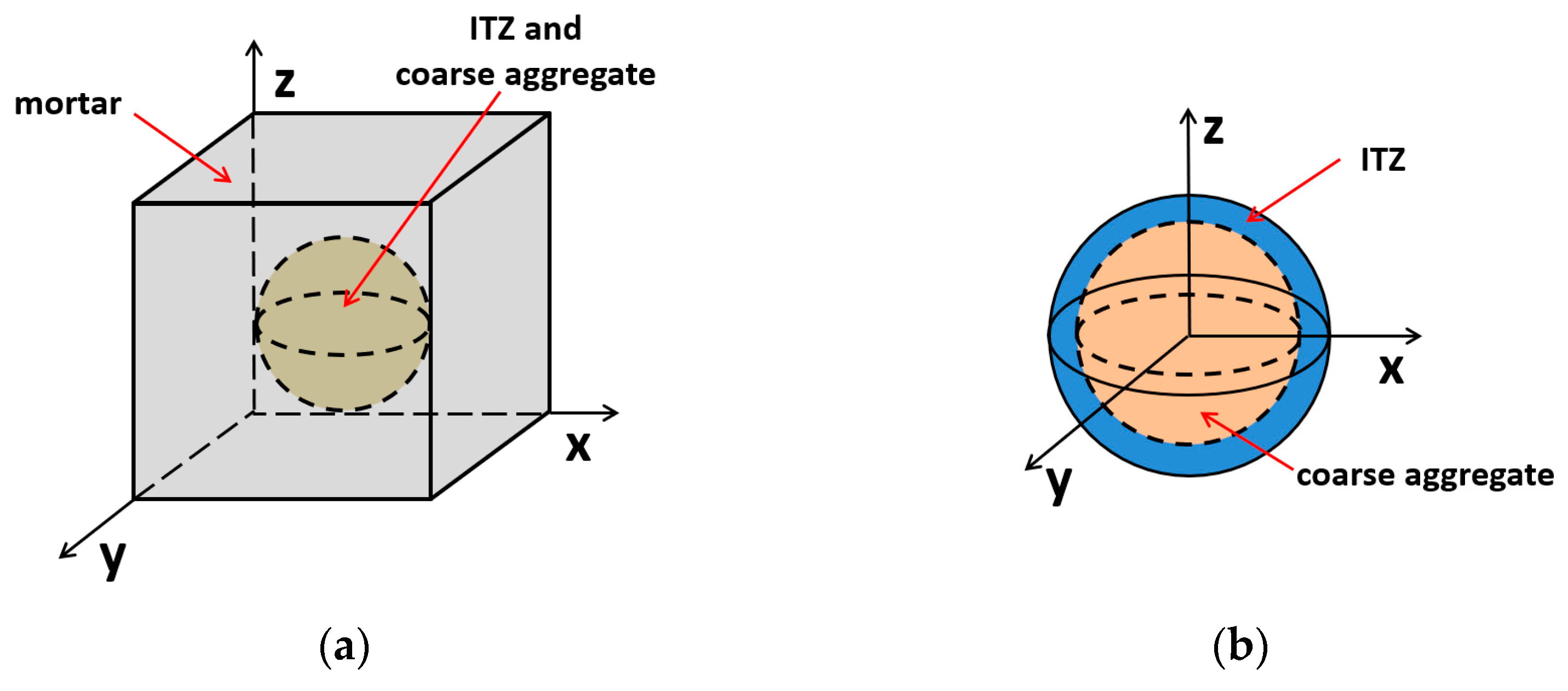
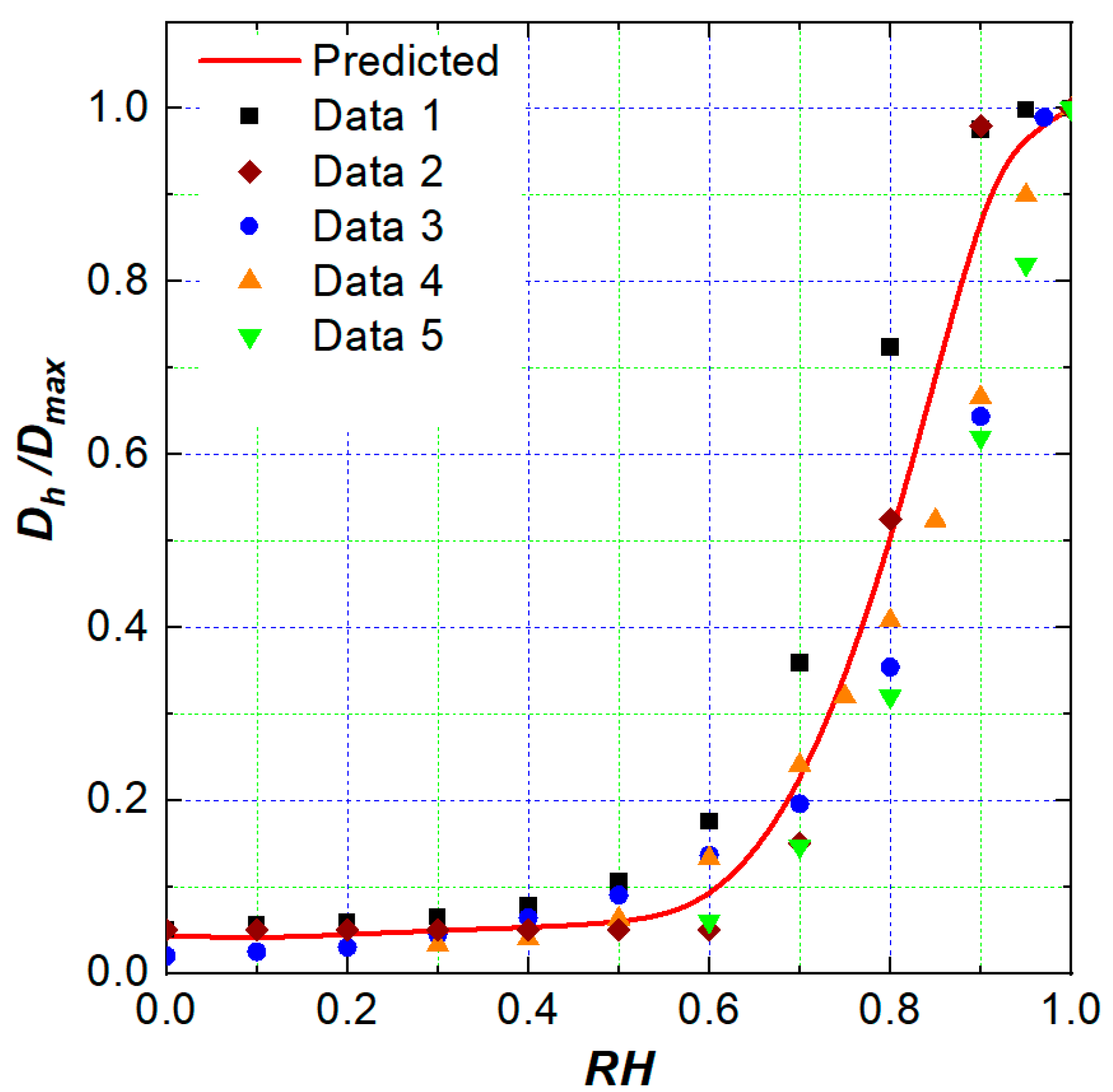
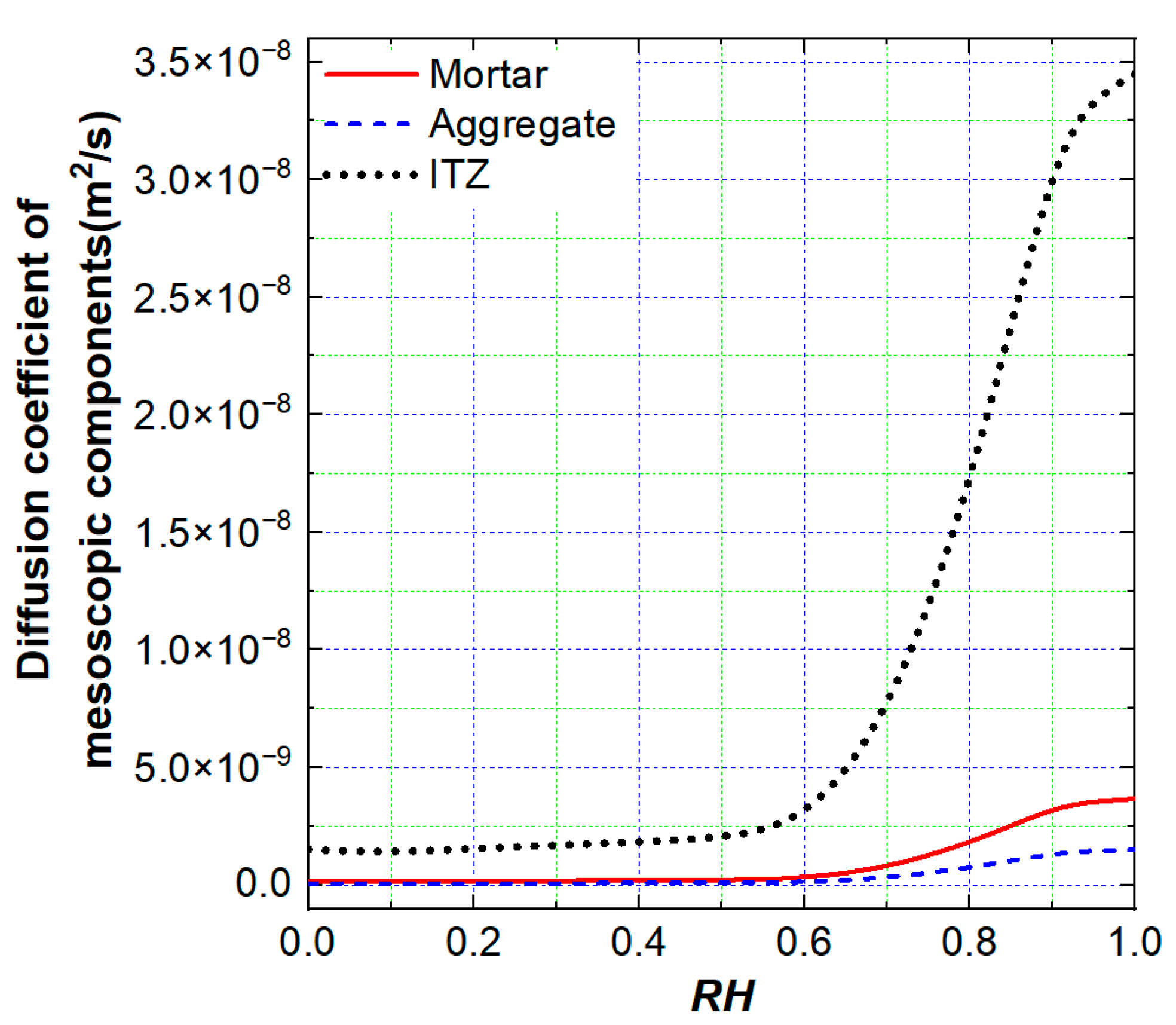
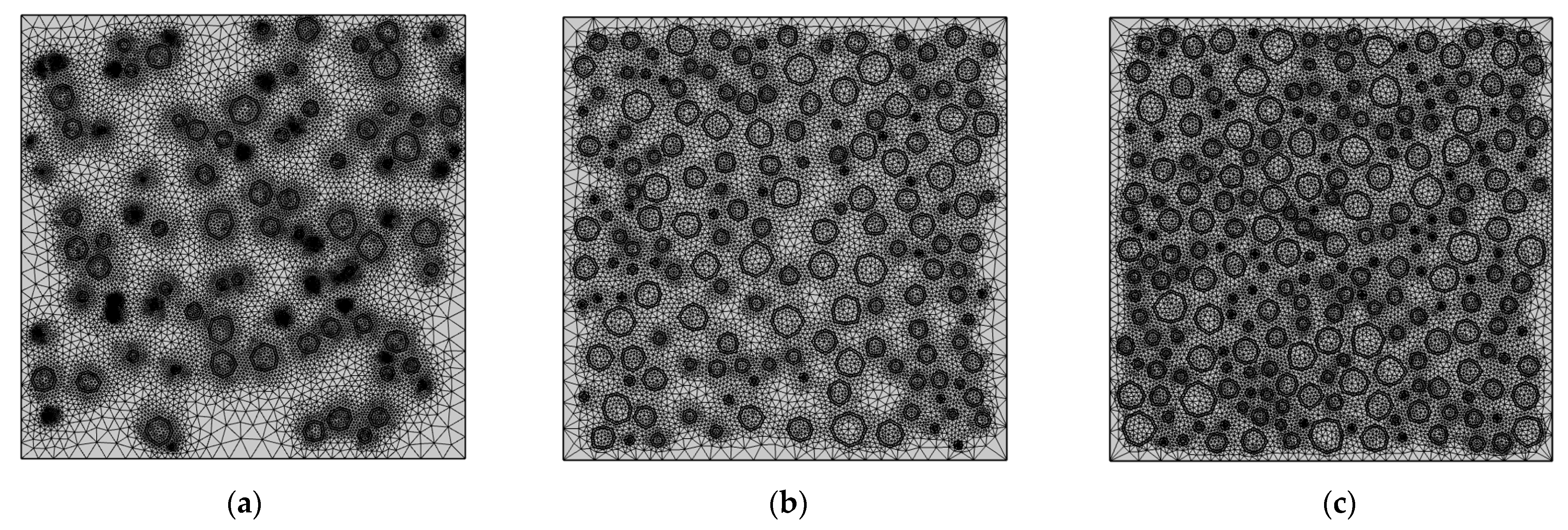


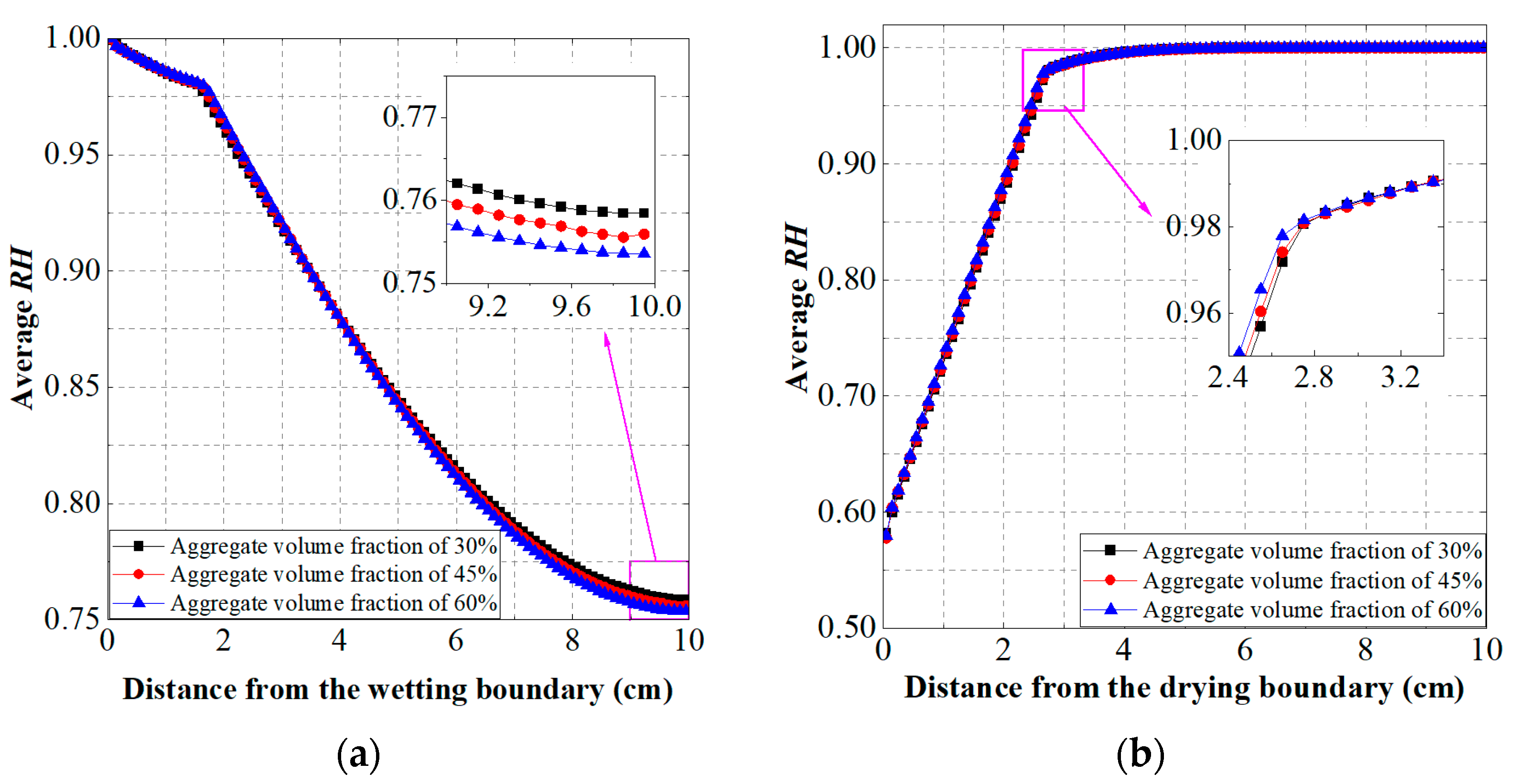
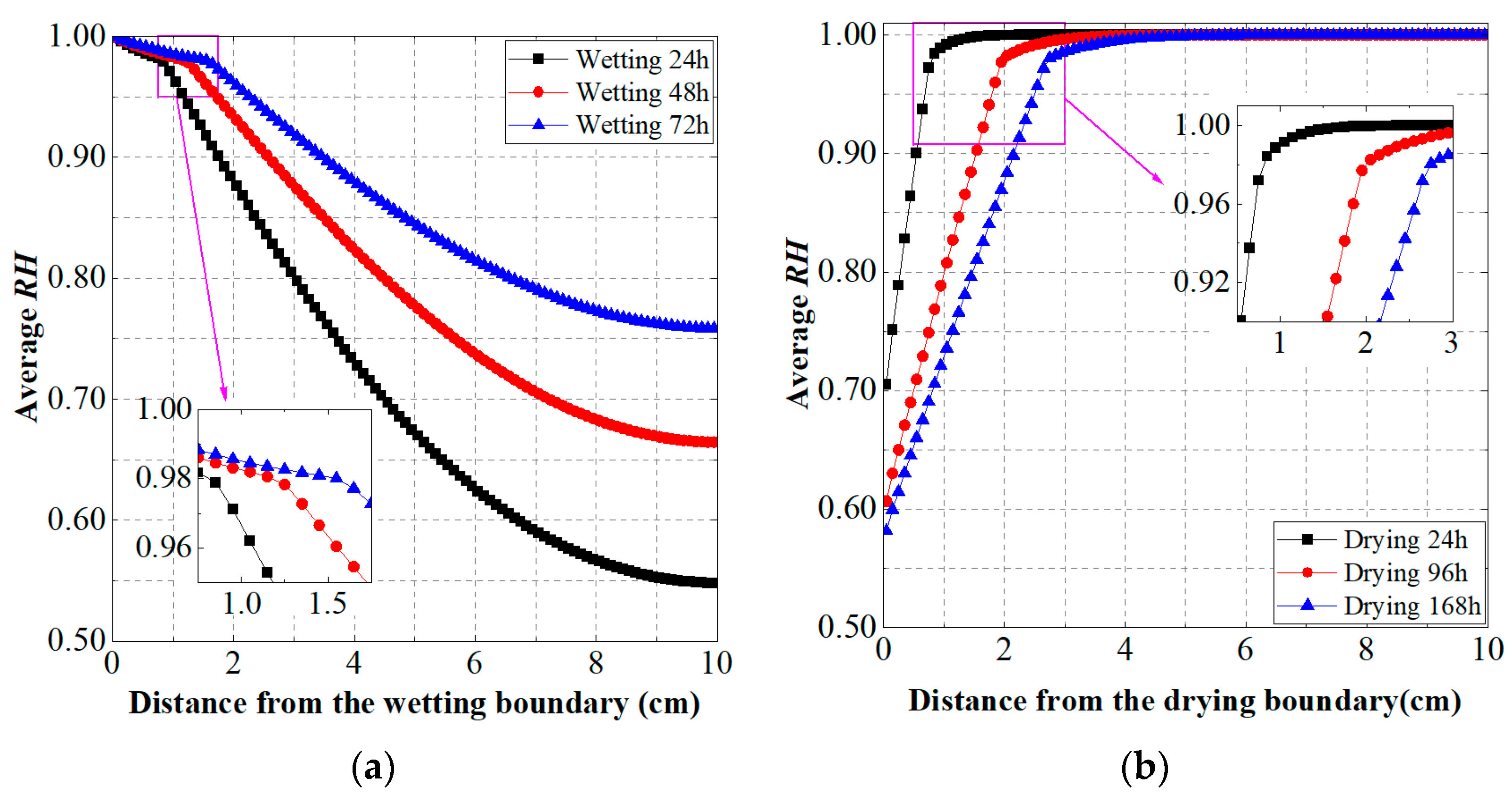
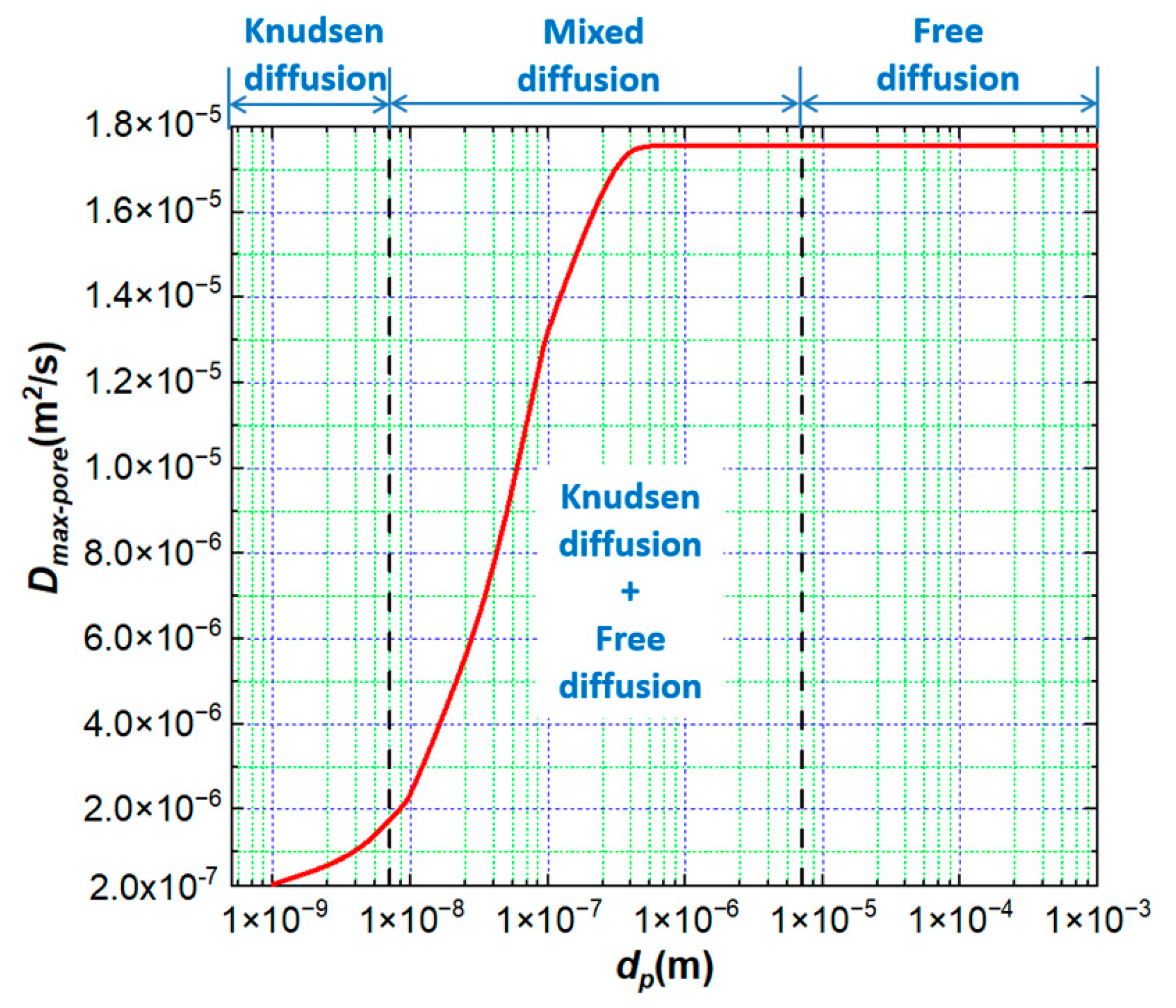
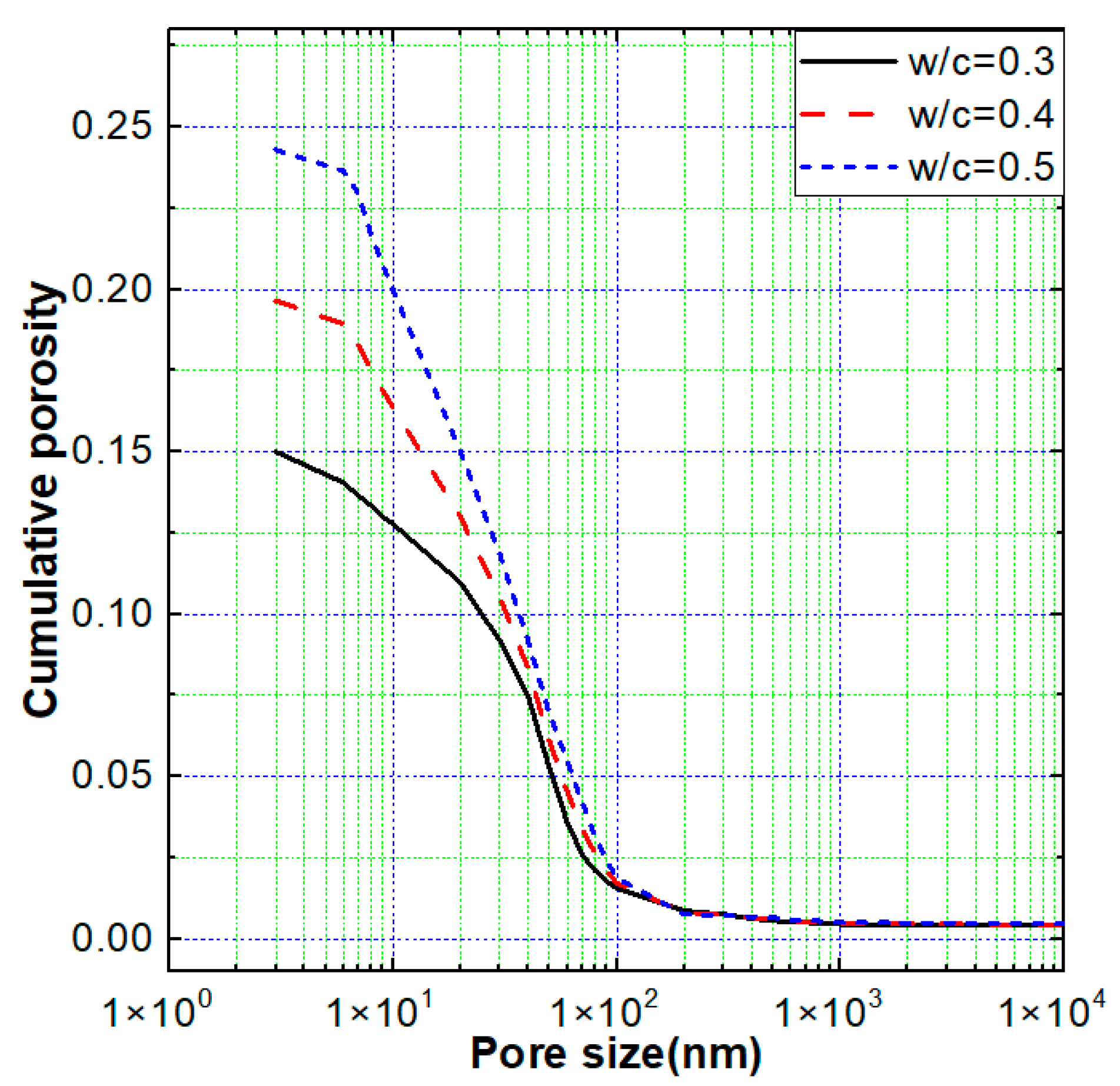
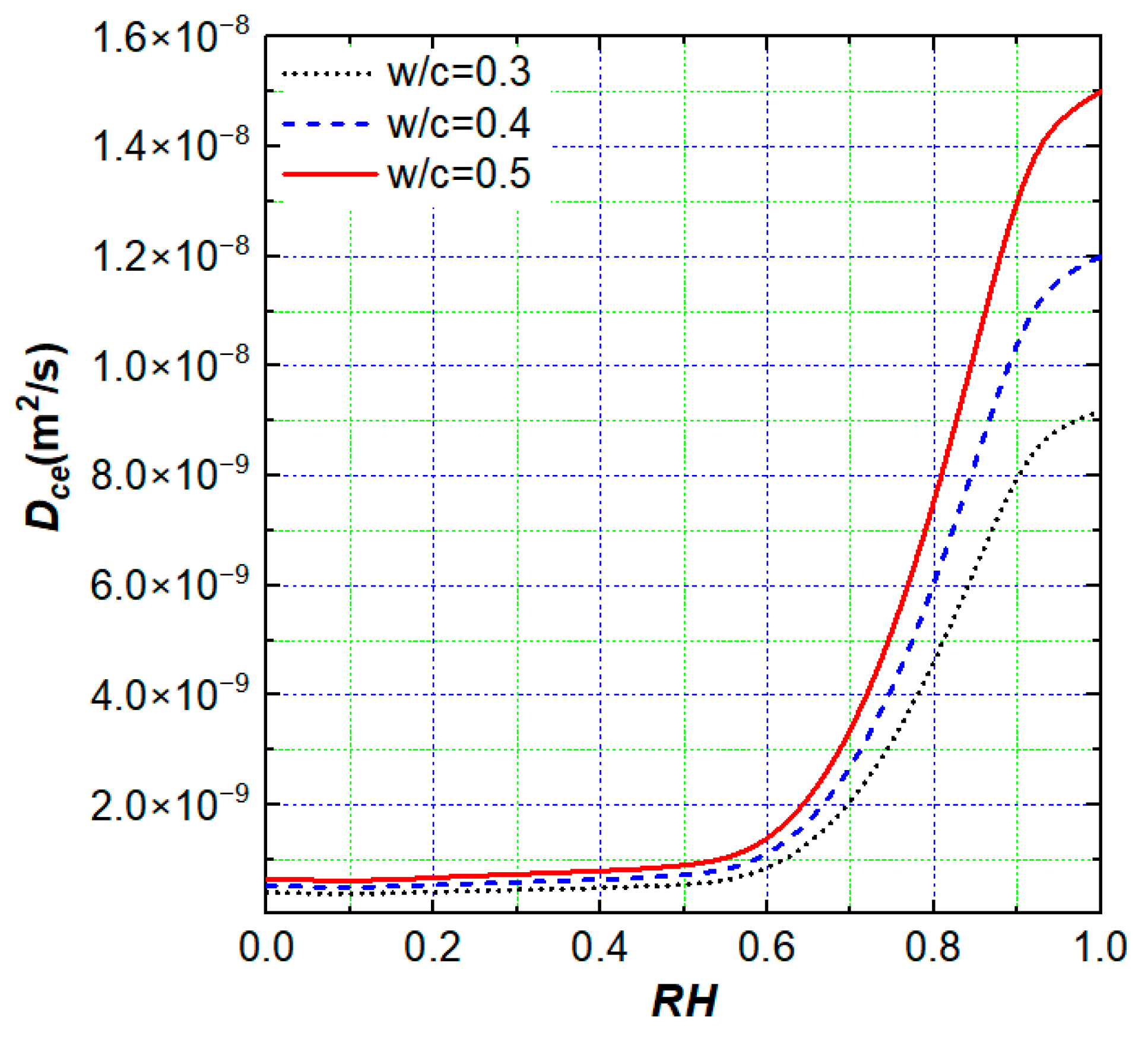

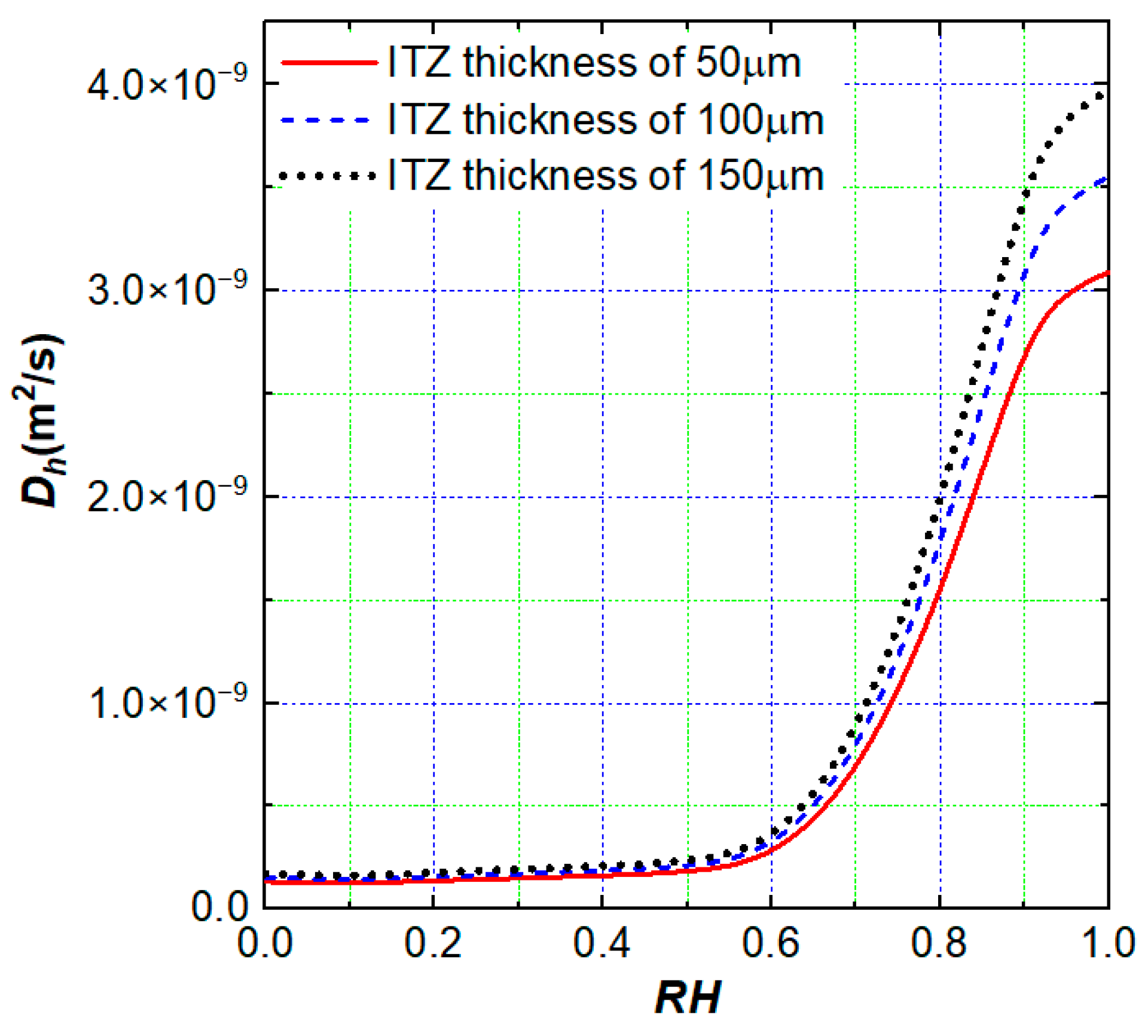
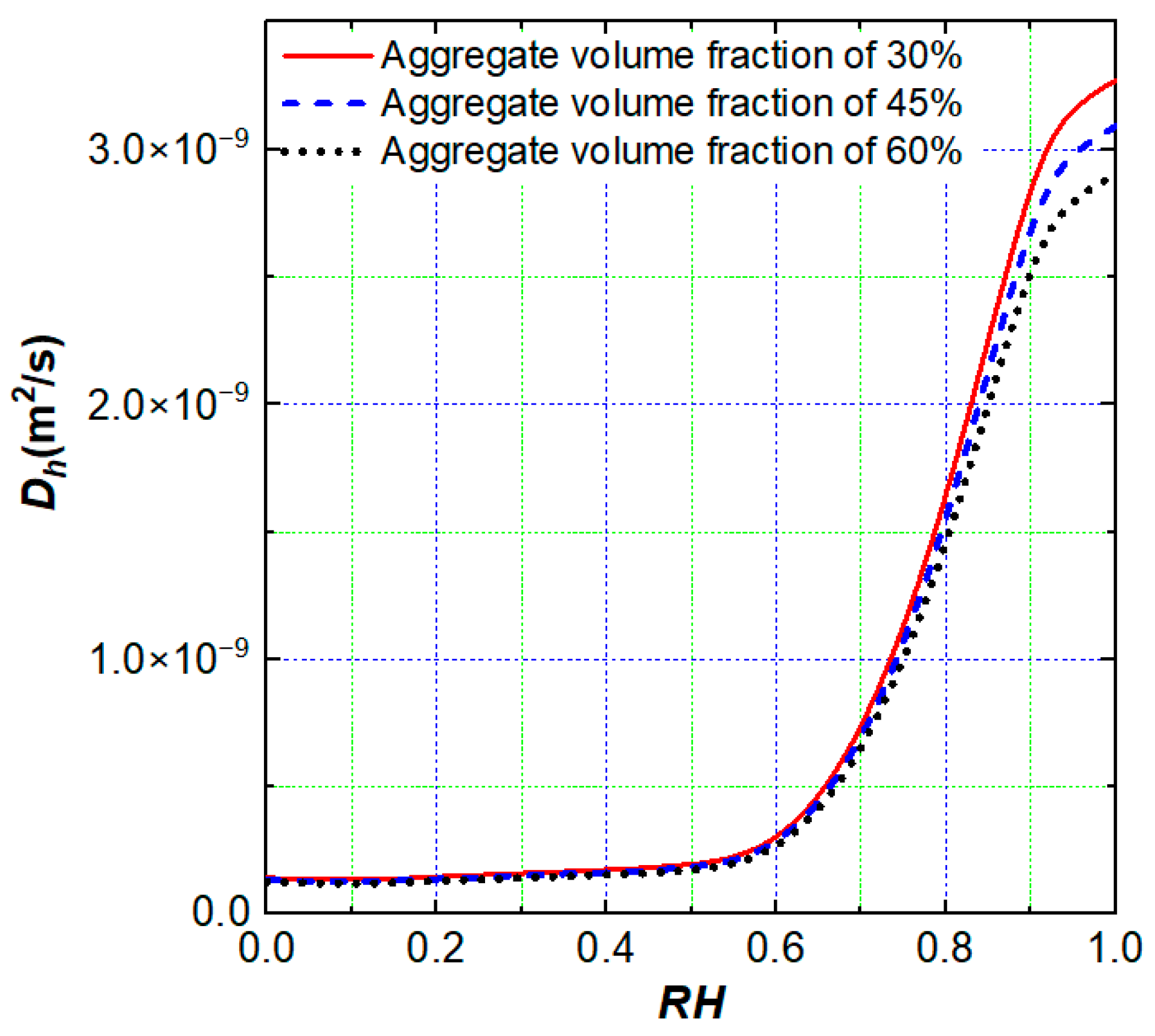
| Working Condition | Boundary Position | Boundary RH | Internal Initial RH |
|---|---|---|---|
| Wetting process | 1 | 0.5 | |
| Drying process | 0.5 | 1 |
Disclaimer/Publisher’s Note: The statements, opinions and data contained in all publications are solely those of the individual author(s) and contributor(s) and not of MDPI and/or the editor(s). MDPI and/or the editor(s) disclaim responsibility for any injury to people or property resulting from any ideas, methods, instructions or products referred to in the content. |
© 2025 by the authors. Licensee MDPI, Basel, Switzerland. This article is an open access article distributed under the terms and conditions of the Creative Commons Attribution (CC BY) license (https://creativecommons.org/licenses/by/4.0/).
Share and Cite
Zhang, X.; Zhang, S.; Chen, B.; Tian, B.; Lu, X.; Xiong, B.; Pan, Z. Study of Concrete Moisture Transfer Characteristics in the Presence of the Concrete Micro–Meso Structure Effect. Appl. Sci. 2025, 15, 1774. https://doi.org/10.3390/app15041774
Zhang X, Zhang S, Chen B, Tian B, Lu X, Xiong B, Pan Z. Study of Concrete Moisture Transfer Characteristics in the Presence of the Concrete Micro–Meso Structure Effect. Applied Sciences. 2025; 15(4):1774. https://doi.org/10.3390/app15041774
Chicago/Turabian StyleZhang, Xiaogang, Shuhua Zhang, Bofu Chen, Bin Tian, Xiaochun Lu, Bobo Xiong, and Zhao Pan. 2025. "Study of Concrete Moisture Transfer Characteristics in the Presence of the Concrete Micro–Meso Structure Effect" Applied Sciences 15, no. 4: 1774. https://doi.org/10.3390/app15041774
APA StyleZhang, X., Zhang, S., Chen, B., Tian, B., Lu, X., Xiong, B., & Pan, Z. (2025). Study of Concrete Moisture Transfer Characteristics in the Presence of the Concrete Micro–Meso Structure Effect. Applied Sciences, 15(4), 1774. https://doi.org/10.3390/app15041774







